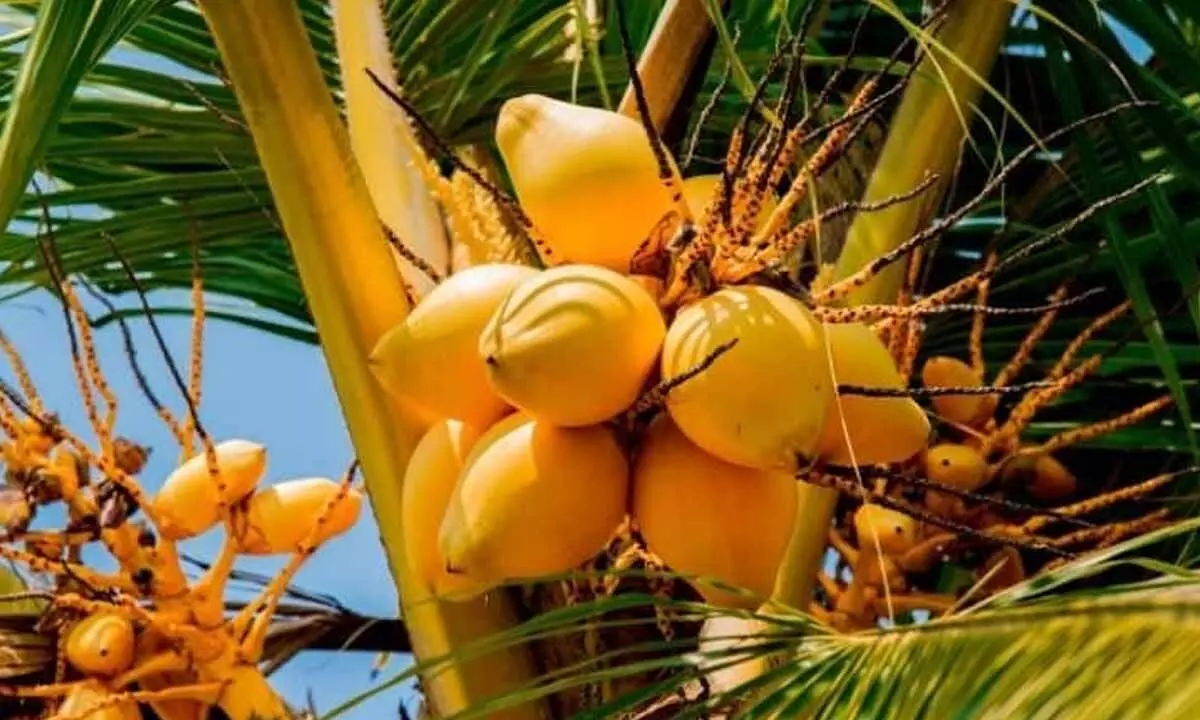More than 12 Varieties of Coconut Grown across the World

More than 12 Varieties of Coconut Grown across the World
- Coconuts Is commercially used and processed fruits
- Each tree has both male and female flowers.
- More than 12 varieties of coconut are grown across the world
Coconuts are produced from the coconut palm, which is one of the few palms producing commercially used and processed fruits.
Once the coconut palm reaches four to six years of age, it begins producing flowers, which eventually develop into the coconuts. Each tree produces both male and female flowers born 3 foot long, canoe-shaped sheaths. There are about 10 to 50 branchlets emerging from the sheath holding both types of yellow flowers.
Here is the list of different types of coconut
1. Malayan Yellow Dwarf Coconuts
These are widely found in tropical areas, these hybrid coconut variants have a significantly high yield. They ideally need free and well drained soil along with plenty organic mulch in the surroundings. Both of these conditions help them to thrive.
These were first developed in the Malaysian region between 1800 and 1900 by early Indonesian planters.
You can find the Malayan yellow Dwarf in varied nations such as Thailand, Brazil and Fiji. Their produce is usually oblong, and the fruit looks medium and it weight around 700 to 800 grams.
2. Fiji Dwarf
One of the biggest qualities of Dwarf Fiji is probably the fact, that is incredibly durable. This tree is robust and it can effectively withstand the poor-quality wind, soil and excessive rainfall. They can successfully thrive in the unexpected condition.
3. Golden Malay
These plants begin to start bearing fruits from a significantly early stage, where the fruits too have a golden orangish hue. As with most other types of coconut, the golden malay is known to produce high-quality drinking water. The flesh of the fruit might also be used for cooking/
4. King Coconut
These are Native to the Sri Lankan region, the king coconut is abundantly found in numerous parts of India. While it is slightly shorter when compared to other variants of palm trees. The king coconut tree to known to grow at an average height of 20 meters producing more than 20 nuts in a bunch. The nuts appear like football with a long and yet oval structure. The size of the fruit is 20 to 30cm in length and their skin has a vibrant organish hue.
5. West coast tall coconut
These can grown in almost every kind of soil. They thrive well in litroral sand and every other kind of soil that can perfectly tolerate moisture. These trees take around six to seven years for bearing fruits and they can yield almost eighty to ninety nuts or palms on an annual basis. These coconuts also yield plenty of water that can later be whipped up into coconut juice.
6. Macapuno coconut
Alternatively known as Kopyor Coconut, this is a dwarf variant of coconut and a type of mutant tree. Being natural mutants, the flesh of these fruits is soft and it is almost similar to the jelly. This usually happen because of its abnormal growth in the endosperm. Over the time, it makes way for an undernourished or collapsed embryo that further leads to the tenderness.
7. Panama Tall
The Panama Tall is a lofty variant, which bears ripe, juicy coconuts. One of the most striking feature of the Panama Tall is its close resemblance to the Jamaica Tall Tree. The biggest difference between both the tree is that, the former has Umbrella shaped canopies while the Jamaican Tall appears more perfectly rounded.
8. Maypan Coconut
These trees can assume a height about 60 feel and they tend to thrive well in hardiness zones from 10 to 11. They require full sun and the moisture requirements are very minimal. Being a cross between the Malayan Dwarf and the Panama Tall, this tree is best known as a hybrid.
9. VHC1 coconut.
A hybrid of the East coast Tall and the Malayan Dwarf, this tree is extremely large and is fertile. It produces fruits after a period of 4 years and annually, you can expect nearing to 80 to 100 coconuts palms from this variant
10. East Coast Tall
This variety has fruit bearing time of around 6 to 8 years, this coconut tree is known to yield around 70 nuts on an annual basis. The coconut from these trees contain around 64% of oil and they thrive best in loamy soils and any tree is moderately tolerant to lethal pests like bugs, mites and insects
11. Tiptur Tall
The Tiptur Tall is known for its leathery fronds that usually produce nearing to 6 to 12 inches long coconuts. It takes around 6 to 7 years as fruit bearing time and can produce around 70 to 80 coconuts annually. Being extremely low maintenance, this is probably one of the best coconut tree variants for home gardeners.
12. Dwarf Orange
With an average lifespan of forty years, this tree can assume a lofty height of around 5 meters. It produces orangish coconuts and takes around three to four years for complete maturation. The coconuts from these trees are best known for their excellent meat content and sweet water.
13. Green Dwarf
These coconut trees are known to yield nearing to 60 to 70 palms annually. They begin fruiting from three to four years and are best known or their dark green drupes. The green dwarf coconut is also susceptible to the root wilt disease.




















